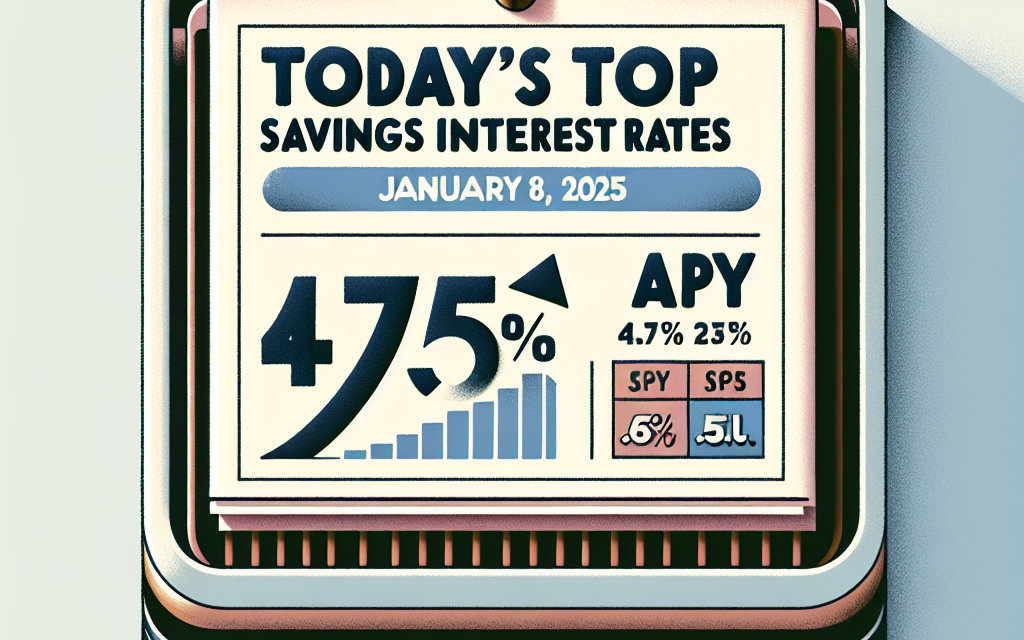“Maximize Your Savings: Unlock 4.75% APY Today!”
Introduction
As of January 8, 2025, today’s top savings interest rates are showcasing competitive offers, with the highest annual percentage yield (APY) reaching an impressive 4.75%. This surge in interest rates reflects a broader trend in the financial landscape, providing savers with attractive opportunities to grow their funds. With various financial institutions vying for customer deposits, individuals can benefit from enhanced returns on their savings, making it an opportune time to explore high-yield savings accounts and maximize their earnings.
Current Savings Interest Rates Overview
As of January 8, 2025, the landscape of savings interest rates presents a compelling opportunity for consumers seeking to maximize their savings. With the highest rates reaching an impressive 4.75% Annual Percentage Yield (APY), individuals are encouraged to explore various financial institutions to find the best options available. This surge in interest rates can be attributed to several economic factors, including the Federal Reserve’s monetary policy adjustments and the ongoing efforts to combat inflation. Consequently, these developments have created a competitive environment among banks and credit unions, leading to attractive offers for savers.
In this context, it is essential to understand how these rates can significantly impact personal finance. A higher APY means that savers can earn more on their deposits over time, which is particularly beneficial for those looking to build an emergency fund or save for future goals. For instance, a savings account with a 4.75% APY can yield substantial returns compared to traditional accounts that offer lower rates. This difference becomes even more pronounced when considering the effects of compound interest, where interest is earned on both the initial principal and the accumulated interest from previous periods.
Moreover, the current savings interest rates are not uniform across all financial institutions. While some banks and credit unions are offering rates as high as 4.75%, others may provide lower yields, making it crucial for consumers to shop around. Online banks, in particular, have emerged as strong contenders in the savings market, often providing higher rates due to their lower overhead costs. As a result, individuals may find that switching to an online bank can lead to more favorable terms and conditions, ultimately enhancing their savings potential.
In addition to comparing interest rates, it is also vital to consider other factors that can influence the overall value of a savings account. For example, fees associated with account maintenance, withdrawal limits, and minimum balance requirements can all affect the net returns on savings. Therefore, consumers should carefully review the fine print of any savings account they are considering. By doing so, they can ensure that they are not only attracted by the high APY but also by the overall account structure that supports their financial goals.
Furthermore, as the economic environment continues to evolve, it is prudent for savers to remain vigilant and adaptable. Interest rates can fluctuate based on various economic indicators, including inflation rates, employment statistics, and global economic conditions. Consequently, what may be an attractive rate today could change in the near future. Therefore, regular monitoring of savings interest rates and being open to switching accounts can help individuals take full advantage of the best available options.
In conclusion, the current savings interest rates, highlighted by the peak of 4.75% APY, present a unique opportunity for consumers to enhance their financial well-being. By understanding the dynamics of these rates and actively seeking out the best offers, individuals can make informed decisions that align with their savings objectives. As the financial landscape continues to shift, staying informed and proactive will be key to maximizing the benefits of high-yield savings accounts. Ultimately, this approach not only fosters financial growth but also empowers individuals to achieve their long-term financial aspirations.
Benefits of High-Interest Savings Accounts
In today’s financial landscape, high-interest savings accounts have emerged as a compelling option for individuals seeking to maximize their savings potential. With interest rates reaching as high as 4.75% APY as of January 8, 2025, these accounts offer a significant advantage over traditional savings accounts, which often yield minimal returns. The benefits of high-interest savings accounts extend beyond mere interest rates; they encompass a range of features that can enhance financial security and growth.
One of the primary advantages of high-interest savings accounts is the ability to earn more on deposited funds. The higher annual percentage yield (APY) translates into increased earnings over time, allowing savers to accumulate wealth more effectively. For instance, a deposit of $10,000 in a high-interest savings account at 4.75% APY would yield approximately $475 in interest over a year, compared to a mere fraction of that amount in a standard account. This difference can be particularly impactful for individuals who prioritize saving for significant life events, such as purchasing a home or funding education.
Moreover, high-interest savings accounts typically offer the same level of safety and security as traditional savings accounts. Most are insured by the Federal Deposit Insurance Corporation (FDIC) up to the legal limit, which provides peace of mind for depositors. This insurance ensures that even in the unlikely event of a bank failure, account holders will not lose their hard-earned money. Consequently, individuals can confidently grow their savings without the fear of losing their principal investment.
In addition to competitive interest rates and security, high-interest savings accounts often come with flexible access to funds. Unlike certificates of deposit (CDs), which may impose penalties for early withdrawals, high-interest savings accounts generally allow for easy access to funds. This liquidity is particularly beneficial for those who may need to tap into their savings for emergencies or unexpected expenses. The ability to withdraw money without incurring fees or penalties makes these accounts an attractive option for both short-term and long-term savers.
Furthermore, many financial institutions offering high-interest savings accounts provide user-friendly online banking features. These digital tools enable account holders to monitor their savings, transfer funds, and manage their finances with ease. The convenience of mobile banking applications allows individuals to stay on top of their savings goals and make informed financial decisions. As technology continues to evolve, the accessibility and functionality of these accounts are likely to improve, further enhancing the overall savings experience.
Another noteworthy benefit of high-interest savings accounts is their role in promoting disciplined saving habits. The prospect of earning higher interest can motivate individuals to save more consistently. By setting up automatic transfers from checking accounts to high-interest savings accounts, savers can cultivate a routine that encourages financial responsibility. This proactive approach not only helps in building a robust savings cushion but also fosters a mindset geared towards long-term financial health.
In conclusion, high-interest savings accounts present a multitude of benefits that can significantly enhance an individual’s financial strategy. With attractive interest rates, security, liquidity, and user-friendly features, these accounts serve as an excellent vehicle for growing savings. As individuals navigate their financial journeys, considering a high-interest savings account can be a prudent step towards achieving their financial goals and securing a stable future.
How to Choose the Best Savings Account
When it comes to selecting the best savings account, several factors warrant careful consideration to ensure that your financial goals are met effectively. First and foremost, the interest rate offered by the savings account is a critical element. As of January 8, 2025, the highest annual percentage yield (APY) stands at an impressive 4.75%. This figure not only highlights the competitive landscape of savings accounts but also underscores the importance of seeking out accounts that provide the best returns on your deposits. A higher APY can significantly enhance your savings over time, making it essential to compare rates across various financial institutions.
In addition to interest rates, it is vital to examine the account’s fees and minimum balance requirements. Some savings accounts may come with monthly maintenance fees that can erode your earnings, while others may require a minimum balance to avoid such charges. Therefore, it is prudent to choose an account that aligns with your financial habits and ensures that you can maintain the required balance without incurring unnecessary costs. Furthermore, some banks offer fee waivers for students or seniors, which can be beneficial if you fall into these categories.
Another important aspect to consider is the accessibility of your funds. While savings accounts are designed for saving rather than spending, you may still want to have easy access to your money in case of emergencies or unexpected expenses. Therefore, it is advisable to look for accounts that offer convenient online banking features, mobile app access, and ATM availability. These features can enhance your banking experience and provide peace of mind knowing that your funds are readily accessible when needed.
Moreover, the reputation and stability of the financial institution should not be overlooked. It is essential to choose a bank or credit union that is insured by the Federal Deposit Insurance Corporation (FDIC) or the National Credit Union Administration (NCUA). This insurance protects your deposits up to $250,000 per depositor, providing an added layer of security for your savings. Researching customer reviews and ratings can also provide insight into the institution’s customer service and overall reliability, which are crucial for a positive banking experience.
Additionally, consider the account’s features beyond just the interest rate and fees. Some savings accounts offer perks such as automatic savings plans, which can help you build your savings effortlessly. These plans allow you to set up regular transfers from your checking account to your savings account, promoting disciplined saving habits. Other accounts may provide tools for budgeting and tracking your savings goals, which can be particularly beneficial for those looking to enhance their financial literacy and management skills.
Lastly, it is wise to periodically review your savings account to ensure it continues to meet your needs. As interest rates fluctuate and new products become available, what may have been the best option a year ago might not hold the same value today. By staying informed about the current market trends and reassessing your financial situation, you can make informed decisions that align with your evolving goals.
In conclusion, choosing the best savings account involves a comprehensive evaluation of interest rates, fees, accessibility, institutional stability, and additional features. By taking the time to analyze these factors, you can select an account that not only maximizes your savings potential but also supports your overall financial well-being.
Impact of Interest Rates on Savings Growth
The impact of interest rates on savings growth is a critical consideration for individuals looking to maximize their financial well-being. As of January 8, 2025, the highest savings interest rate stands at an impressive 4.75% APY, a figure that significantly influences the potential growth of savings accounts. Understanding how these rates affect savings can empower consumers to make informed decisions about where to allocate their funds.
To begin with, interest rates serve as a fundamental driver of savings growth. When individuals deposit money into a savings account, they expect to earn interest on their balance over time. The annual percentage yield (APY) reflects the total amount of interest earned on an account over a year, taking into account the effects of compounding. Therefore, a higher APY translates directly into greater earnings on deposited funds. For instance, with a 4.75% APY, a savings account holder can expect their money to grow more rapidly compared to accounts offering lower rates. This growth is particularly significant over extended periods, as the effects of compounding can lead to exponential increases in savings.
Moreover, the current economic climate plays a pivotal role in determining interest rates. Central banks, such as the Federal Reserve in the United States, adjust interest rates in response to various economic indicators, including inflation and employment levels. When the economy is robust, central banks may raise interest rates to curb inflation, which can lead to higher savings rates. Conversely, during economic downturns, rates may be lowered to stimulate spending and investment. As a result, consumers must remain vigilant and adaptable, as shifts in the economic landscape can directly impact the interest rates offered by financial institutions.
In addition to the direct correlation between interest rates and savings growth, it is essential to consider the broader implications of these rates on consumer behavior. Higher interest rates can incentivize individuals to save more, as the potential for earning greater returns becomes more appealing. This shift in behavior can lead to increased financial security for households, as individuals prioritize saving over spending. Furthermore, a culture of saving can contribute to overall economic stability, as higher savings rates can lead to increased capital available for investment in businesses and infrastructure.
However, it is also important to recognize that not all savings accounts are created equal. While a 4.75% APY is attractive, consumers should carefully evaluate the terms and conditions associated with different accounts. Factors such as minimum balance requirements, fees, and withdrawal limitations can significantly affect the net returns on savings. Therefore, conducting thorough research and comparing various financial institutions is crucial for maximizing savings growth.
In conclusion, the impact of interest rates on savings growth cannot be overstated. With the current highest savings interest rate at 4.75% APY, individuals have a unique opportunity to enhance their financial future through strategic saving. By understanding the relationship between interest rates and savings, as well as the broader economic context, consumers can make informed decisions that align with their financial goals. Ultimately, being proactive in managing savings accounts and staying informed about changing interest rates will empower individuals to achieve greater financial stability and growth over time.
Comparison of Online vs. Traditional Banks
As individuals seek to maximize their savings in an environment where interest rates are increasingly competitive, the choice between online banks and traditional banks becomes a significant consideration. Both types of institutions offer savings accounts, but they differ markedly in terms of interest rates, accessibility, and overall customer experience. Understanding these differences is crucial for consumers aiming to make informed financial decisions.
Online banks have gained considerable traction in recent years, primarily due to their ability to offer higher interest rates on savings accounts. As of January 8, 2025, some online banks are providing annual percentage yields (APY) as high as 4.75%. This is a stark contrast to many traditional banks, which often offer rates that hover around 0.01% to 0.10%. The disparity in interest rates can be attributed to the lower overhead costs associated with online banking. Without the need for physical branches, online banks can pass on the savings to their customers in the form of higher interest rates. Consequently, consumers looking to grow their savings more effectively may find online banks to be a more attractive option.
In addition to higher interest rates, online banks typically offer a streamlined and user-friendly digital experience. Most online banking platforms are designed with intuitive interfaces that allow customers to manage their accounts easily from their computers or mobile devices. This convenience is particularly appealing to tech-savvy individuals who prefer to conduct their banking activities without the constraints of traditional banking hours. Furthermore, many online banks provide robust mobile applications that enable users to deposit checks, transfer funds, and monitor their accounts in real time, enhancing the overall banking experience.
On the other hand, traditional banks offer a level of personal interaction that some customers may find invaluable. For individuals who prefer face-to-face communication, traditional banks provide the opportunity to speak directly with banking representatives. This can be particularly beneficial for those who have complex financial needs or require assistance with specific banking products. Additionally, traditional banks often have a more established presence in local communities, which can foster a sense of trust and reliability among customers. For some, the ability to visit a physical branch and speak with a representative can be a deciding factor when choosing where to bank.
Moreover, traditional banks may offer a wider range of financial products and services beyond savings accounts, including loans, mortgages, and investment options. This comprehensive approach can be advantageous for customers looking to consolidate their banking needs under one roof. However, it is essential to note that while traditional banks may provide a broader array of services, they often do so at the expense of higher fees and lower interest rates on savings accounts.
In conclusion, the decision between online and traditional banks ultimately hinges on individual preferences and financial goals. For those prioritizing high interest rates and convenience, online banks present a compelling option. Conversely, individuals who value personal interaction and a diverse range of financial services may find traditional banks more suitable. As consumers navigate this landscape, it is crucial to weigh the benefits and drawbacks of each type of institution carefully. By doing so, they can make informed choices that align with their financial aspirations and needs, ensuring that their savings work as effectively as possible in today’s competitive market.
Strategies for Maximizing Savings Interest
In the current financial landscape, where savings interest rates are experiencing fluctuations, it is essential for individuals to adopt effective strategies to maximize their savings interest. As of January 8, 2025, the highest annual percentage yield (APY) stands at an impressive 4.75%. This figure not only highlights the potential for growth in savings accounts but also underscores the importance of being proactive in managing one’s finances. To capitalize on these favorable rates, individuals should consider several key strategies that can enhance their savings potential.
First and foremost, it is crucial to shop around for the best savings accounts available. Financial institutions often offer varying interest rates, and even a small difference in APY can significantly impact the growth of savings over time. By comparing rates from different banks and credit unions, individuals can identify accounts that provide the highest returns. Additionally, online banks frequently offer more competitive rates than traditional brick-and-mortar institutions, making them an attractive option for savvy savers. Therefore, conducting thorough research and utilizing online comparison tools can lead to more informed decisions regarding where to deposit funds.
Moreover, individuals should consider the benefits of high-yield savings accounts. These accounts typically offer higher interest rates than standard savings accounts, making them an excellent choice for those looking to maximize their earnings. While high-yield accounts may come with certain requirements, such as maintaining a minimum balance or making a limited number of withdrawals, the potential for increased interest earnings often outweighs these considerations. Consequently, individuals should evaluate their financial habits and determine whether a high-yield savings account aligns with their goals.
In addition to selecting the right type of account, it is also beneficial to automate savings. By setting up automatic transfers from checking accounts to savings accounts, individuals can ensure that they consistently contribute to their savings without the temptation to spend. This strategy not only fosters a disciplined approach to saving but also allows individuals to take advantage of compound interest over time. As funds accumulate, the interest earned on the principal amount can lead to exponential growth, further enhancing the overall savings balance.
Furthermore, individuals should remain vigilant about interest rate changes and be prepared to switch accounts if necessary. Financial institutions periodically adjust their rates based on market conditions, and what may be the best option today could change in the future. By staying informed about current rates and being willing to move funds to a more advantageous account, individuals can continue to maximize their savings interest. This proactive approach requires regular monitoring of financial news and updates from banks, ensuring that savers are always aware of the best available options.
Lastly, it is important to consider the impact of fees on savings interest. Some accounts may charge monthly maintenance fees or transaction fees that can erode the benefits of higher interest rates. Therefore, individuals should carefully read the terms and conditions of any savings account they consider and opt for those with minimal or no fees. By minimizing costs associated with savings accounts, individuals can retain more of their interest earnings, ultimately leading to greater financial growth.
In conclusion, maximizing savings interest requires a combination of strategic account selection, automation, vigilance, and cost management. By implementing these strategies, individuals can take full advantage of today’s top savings interest rates, ensuring that their hard-earned money works as effectively as possible for their financial future.
Future Trends in Savings Interest Rates
As we look ahead to the future of savings interest rates, it is essential to consider the various economic factors that influence these rates and how they may evolve in the coming months and years. Currently, savings accounts are offering competitive interest rates, with some institutions providing annual percentage yields (APY) as high as 4.75%. However, the sustainability of these rates is contingent upon a multitude of variables, including inflation, Federal Reserve policies, and overall economic conditions.
One of the primary drivers of savings interest rates is the monetary policy set by the Federal Reserve. The Fed’s decisions regarding interest rates directly impact the cost of borrowing and the returns on savings. In recent years, the Fed has adopted a more aggressive stance in response to rising inflation, which has led to increased interest rates across various financial products. As inflationary pressures begin to stabilize, it is plausible that the Fed may shift its approach, potentially leading to a decrease in savings interest rates. This scenario could result in lower APYs for consumers, making it crucial for savers to remain vigilant and informed about the evolving landscape.
Moreover, the competitive nature of the banking industry plays a significant role in shaping savings interest rates. Financial institutions are continually vying for customers, and attractive interest rates can be a powerful tool in this competition. As more banks and credit unions enter the market with high-yield savings accounts, consumers may benefit from increased options and better rates. However, this competition may also lead to a normalization of rates as institutions adjust their offerings in response to market dynamics. Therefore, while current rates may seem favorable, it is essential to recognize that they may not be sustainable in the long term.
In addition to these factors, technological advancements are also influencing the future of savings interest rates. The rise of online banks and fintech companies has disrupted traditional banking models, often allowing these institutions to offer higher interest rates due to lower overhead costs. As digital banking continues to gain traction, it is likely that consumers will see a broader range of savings products with varying interest rates. This shift could encourage traditional banks to enhance their offerings to remain competitive, potentially leading to a more favorable environment for savers.
Furthermore, consumer behavior and preferences are evolving, which may also impact savings interest rates. As individuals become more financially literate and aware of their options, they are increasingly seeking out high-yield savings accounts and other investment vehicles that offer better returns. This shift in consumer demand may prompt banks to adjust their interest rates accordingly, as they strive to attract and retain customers in a more informed marketplace.
In conclusion, while today’s top savings interest rates are indeed appealing, the future remains uncertain. Factors such as Federal Reserve policies, competitive banking practices, technological advancements, and changing consumer behaviors will all play a crucial role in determining the trajectory of savings interest rates. As we move forward, it is essential for savers to stay informed and adaptable, recognizing that the financial landscape is continually evolving. By doing so, they can make informed decisions that align with their financial goals, ensuring that they maximize their savings potential in an ever-changing environment.
Q&A
1. **What is the highest savings interest rate available as of January 8, 2025?**
4.75% APY.
2. **Which type of account typically offers the highest interest rates?**
High-yield savings accounts.
3. **Are interest rates the same across all banks?**
No, interest rates can vary significantly between different banks and financial institutions.
4. **What factors influence savings interest rates?**
Economic conditions, central bank policies, and competition among banks.
5. **Is the 4.75% APY a promotional rate?**
It may be, as some banks offer promotional rates for new customers or specific terms.
6. **How often is interest typically compounded in savings accounts?**
Interest is commonly compounded daily, monthly, or quarterly.
7. **What should consumers consider when choosing a savings account with a high interest rate?**
Fees, minimum balance requirements, withdrawal limits, and the bank’s overall reputation.
Conclusion
As of January 8, 2025, today’s top savings interest rates reach a high of 4.75% APY, reflecting a competitive environment for savers. This rate offers an attractive opportunity for individuals looking to maximize their savings, particularly in a landscape where inflation concerns persist. Overall, these elevated rates can significantly enhance the growth potential of savings accounts, encouraging consumers to take advantage of the favorable conditions.





